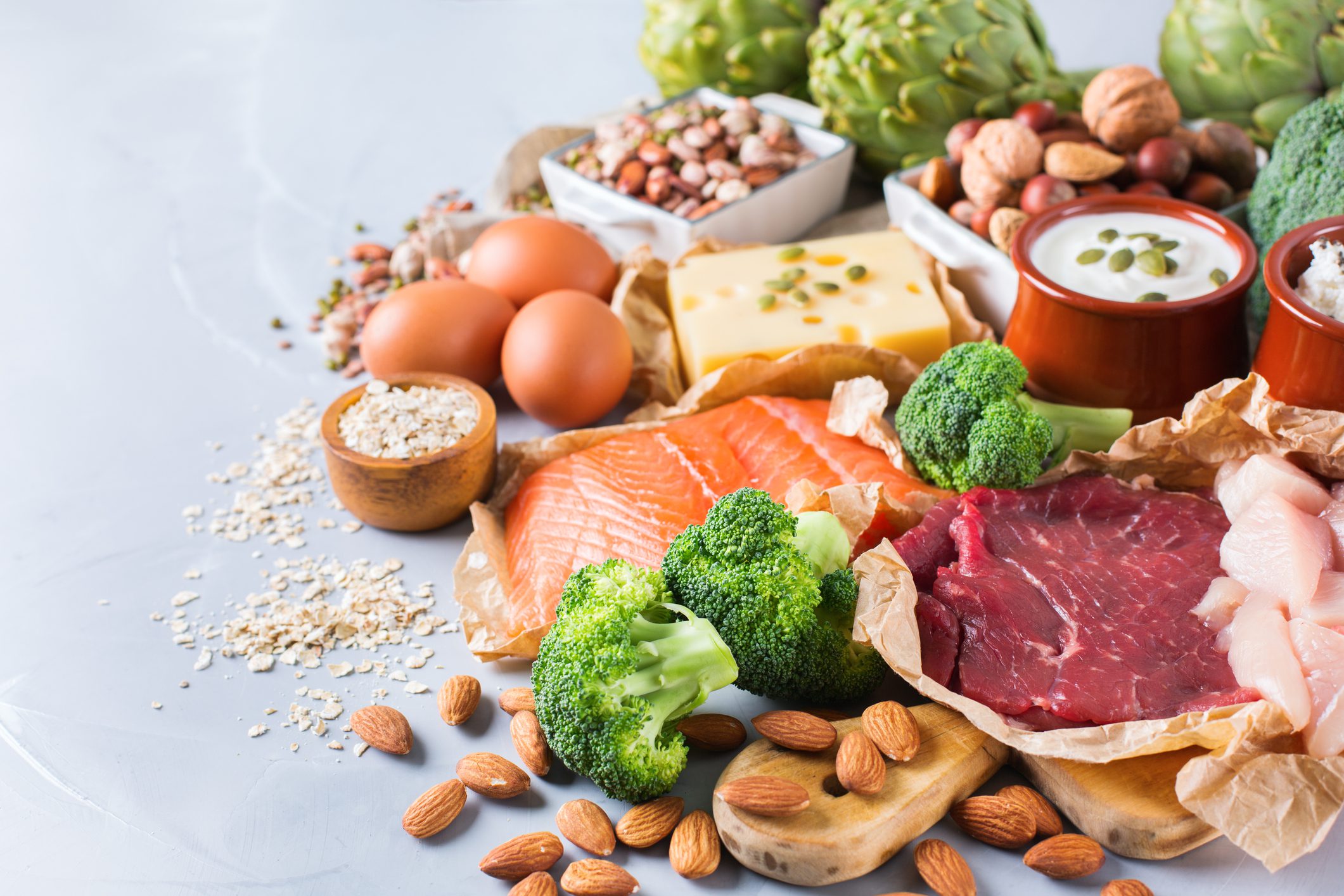Meeting your daily protein quota requires a little bit of strategy in your meal planning. Among the decisions you make is the choice between animal or plant protein to reach your goals.
When I say animal protein, I’m referring to things like grass-fed beef, wild-caught seafood, and (if you’re not intolerant) pasture-raised eggs. These foods help you meet the 100+ grams of protein you need daily. Plant foods make it a bit more challenging to get those amounts.
While I’ll look at both types here, I encourage people to focus on animal protein, which is far more efficient than what most plant proteins can provide.
Why You Need Protein In Your Diet
Before considering whether animal or plant protein is your better option, let’s start with a more fundamental question: why should you get 100+ grams of protein per day?
Maintaining strong muscle is one big reason. Studies show that once you hit 30, you lose 3-8% of your muscle mass every decade. After 60, this decline becomes even more pronounced.1 Lifting heavy is the key to maintaining strong muscle as you age. Getting high-quality protein complements those efforts, supporting muscle synthesis and repair.
Which is better for building and maintaining muscle: animal or plant protein?
One review of 16 studies looked at how both types can impact various aspects of muscle health. Researchers found that compared with plant protein, animal protein better supported lean mass (which includes the weight of your muscle, bones, and body fluid).2
One reason why: animal-based diets contain higher amounts of the branch chain amino acid (BCAA) leucine along with other critical amino acids that support muscle protein synthesis and repair.3 A high-protein diet also supports body composition, satiety, a well-functioning immune system, and so much more.4
Those are among the many reasons I want you to get sufficient protein every day. Depending on your goals, you’ll want to aim for 0.7 to 1 gram of protein per pound of your ideal body weight.
There’s no need to do any math: this calculator can help you determine your needs. Once you know your number, you’ll want to stock up on the best-quality protein sources to meet your daily mark.
With that number in mind, you’re ready to determine your best protein sources.
Animal vs. Plant Protein
Below, I look at three factors in animal and plant protein to help you meet your overall protein intake, so you maximize the many benefits this macronutrient provides.
Overall Protein Quality: Animal Protein for the Win
Your body breaks down protein into amino acids to help build muscle, produce hormones and enzymes, and so much more.
Amino acids fall into two categories: essential and non-essential.
“Essential” means your body can’t make these amino acids (scientists have identified nine of them), so you need to get them from food or supplements. Your body can make other non-essential amino acids.5
Animal protein like grass-fed beef, pasture-raised poultry, and wild-caught salmon are “complete” proteins, meaning they contain all nine essential amino acids. Plant protein, on the other hand, may be low in one or more essential amino acids, making them “incomplete” proteins.6
Scientists use a system to determine protein quality—its ability to meet amino-acid requirements along with how well we digest that protein—called the protein digestibility-corrected amino acid score (PDCAAS).
Most animal-based protein sources have PDCAAS at or very near 1.00, meaning that your body digests and absorbs those amino acids incredibly well. Plant protein, on the other hand, may be low in one or more essential amino acids. As a result, they have a lower PDCAAS.
On the higher end of the spectrum, pea protein ranks at 0.82. For black beans, the PDCAAS is 0.75. Many plant-based foods, however, are even lower.
Legumes, for example, are low in the sulfur-containing amino acids methionine and cysteine. (Among its benefits, sulfur helps protect you from damaging free radicals.)7
Because of their less-favorable amino-acid profile, research shows that your body can’t absorb or utilize those amino acids from plant protein as well.8 In other words, even if you are meeting your protein requirements, your body might not be absorbing or utilizing plant protein effectively.
Nutrient Content: Animal and Plant Protein Both Have Pros and Cons
I recently wrote about the superior nutrition of red meat, including its wide array of vitamins, minerals, and essential nutrients. Grass-fed meats also provide healthy fats, including the anti-inflammatory omega-3 fatty acids, EPA and DHA.9
Likewise, the omega-3s in wild-caught fish like salmon can lower the chronic inflammation that can contribute to heart disease and other problems. Wild-caught seafood is high in vitamin D, selenium, B vitamins, and an antioxidant called astaxanthin.10
Plant proteins, on the other hand, fall short in several critical nutrients. They can be deficient in vitamin B12, crucial for the nervous system and red blood cell production.11
While plant proteins like flax seed and chia seed contain another anti-inflammatory omega-3 known as ALA, your body does a lousy job converting that ALA to the longer-chain (and more important fatty acids) EPA and DHA. On average, research shows that only 1-10% of ALA is converted into EPA and 0.5-5% into DHA.12
In other words, even if you’re getting enough ALA, you may not convert it well to the longer-chain fatty acids that your body needs. What’s more, some plant-based protein sources contain anti-nutrients like phytic acid, which can bind to minerals and make them less available for absorption.
To be fair, plant protein does provide nutrients, including vitamin C as well as other vitamins and minerals. Many are also high in fiber, which can help you feel fuller for longer and support gut health.13
Meeting Your Overall Protein Intake: Animal Protein Is a Clear Winner
Do a quick Google search about whether you can meet your protein needs from plant foods alone, and you’ll find many enthusiastic bloggers and experts suggesting a resounding yes.
They miss one critical point: most protein recommendations are dismally low. Some critics believe the Recommended Dietary Allowance (RDA) of protein isn’t nearly enough to promote all its benefits, including healthy aging, finding your ideal weight, and supporting athletic performance.14
I mentioned earlier that animal protein is more bioavailable, meaning that you digest and absorb more of the amino acids your body needs compared with plant protein. But the total amounts of protein they provide are miles apart, too. Six ounces of cooked chicken breast contains about 52 grams of protein. You’d have to eat about 22 cups of broccoli to get that amount of protein!
Of course, some plant proteins do provide solid amounts of protein. A cup of legumes contains 18 grams of protein, and other legumes aren’t far behind. But there are very few plant-based sources that contain those high amounts of protein.
To compensate, vegans and vegetarians often over-rely on foods like gluten, soy, dairy, and eggs, which provide protein at a metabolic cost. Repeatedly eaten, they can become food intolerances that create havoc throughout the body. Studies show that people who focus primarily on plant protein lack diversity: most of their intake came from grains, which is a lousy source of protein.15
What’s the Solution? Merging the Benefits of Animal and Plant Proteins
Animal and plant proteins both carry their own benefits and drawbacks. Overall, the research is conflicting.16 From my perspective, animal protein gives you the biggest overall bang for your buck.
“But meat is so expensive,” someone will occasionally say. While plant protein might initially seem better from a cost perspective, you’ll have to eat far more of it to meet your protein needs.
Still, I get it: animal protein sources can be pricey compared with plant-based sources, particularly if you opt for organic, grass-fed, or free-range options (which are the only ones you should choose).
A few of my favorite options for sourcing high-quality meat and fish: ButcherBox, Thrive Market, and Vital Choice.** All three offer monthly subscriptions so you never have to worry about running out of good-for-you protein options.
When it comes to animal protein, quality matters enormously. You are what you eat, ate. You don’t want to compromise there.
My solution: eat by the plate, center on quality animal protein sources, and fill the rest of your plate with lots of antioxidant-and-fiber-boosting leafy and cruciferous veggies along with some slow low carbs. Regardless of whether you choose plant or animal protein, getting 100 grams of protein is entirely possible. With plant protein, it simply demands more work.
All-In-One Shakes are the easiest, most effective ways to meet your protein quota. Whether you opt for animal or plant protein, every serving provides 20+ of high-quality protein, along with vitamins, minerals, fiber, healthy fats, and phytonutrients.*
References:
- Volpi E, Nazemi R, Fujita S. Muscle tissue changes with aging. Curr Opin Clin Nutr Metab Care. 2004 Jul;7(4):405-10. doi: 10.1097/01.mco.0000134362.76653.b2. PMID: 15192443; PMCID: PMC2804956.
- Lim MT, Pan BJ, Toh DWK, Sutanto CN, Kim JE. Animal Protein versus Plant Protein in Supporting Lean Mass and Muscle Strength: A Systematic Review and Meta-Analysis of Randomized Controlled Trials. Nutrients. 2021 Feb 18;13(2):661. doi: 10.3390/nu13020661. PMID: 33670701; PMCID: PMC7926405.
- Ewy MW, Patel A, Abdelmagid MG, Mohamed Elfadil O, Bonnes SL, Salonen BR, Hurt RT, Mundi MS. Plant-Based Diet: Is It as Good as an Animal-Based Diet When It Comes to Protein? Curr Nutr Rep. 2022 Jun;11(2):337-346. doi: 10.1007/s13668-022-00401-8. Epub 2022 Feb 22. PMID: 35194768.
- Ferrari L, Panaite SA, Bertazzo A, Visioli F. Animal- and Plant-Based Protein Sources: A Scoping Review of Human Health Outcomes and Environmental Impact. Nutrients. 2022 Dec 1;14(23):5115. doi: 10.3390/nu14235115. PMID: 36501146; PMCID: PMC9741334.
- Hou Y, Wu G. Nutritionally Essential Amino Acids. Adv Nutr. 2018 Nov 1;9(6):849-851. doi: 10.1093/advances/nmy054. PMID: 30239556; PMCID: PMC6247364.
- Hertzler SR, Lieblein-Boff JC, Weiler M, Allgeier C. Plant Proteins: Assessing Their Nutritional Quality and Effects on Health and Physical Function. Nutrients. 2020 Nov 30;12(12):3704. doi: 10.3390/nu12123704. PMID: 33266120; PMCID: PMC7760812.
- Hertzler SR, Lieblein-Boff JC, Weiler M, Allgeier C. Plant Proteins: Assessing Their Nutritional Quality and Effects on Health and Physical Function. Nutrients. 2020 Nov 30;12(12):3704. doi: 10.3390/nu12123704. PMID: 33266120; PMCID: PMC7760812.
- Reid-McCann RJ, Brennan SF, McKinley MC, McEvoy CT. The effect of animal versus plant protein on muscle mass, muscle strength, physical performance and sarcopenia in adults: protocol for a systematic review. Syst Rev. 2022 Apr 13;11(1):64. doi: 10.1186/s13643-022-01951-2. PMID: 35418173; PMCID: PMC9006591.
- Nogoy KMC, Sun B, Shin S, Lee Y, Zi Li X, Choi SH, Park S. Fatty Acid Composition of Grain- and Grass-Fed Beef and Their Nutritional Value and Health Implication. Food Sci Anim Resour. 2022 Jan;42(1):18-33. doi: 10.5851/kosfa.2021.e73. Epub 2022 Jan 1. PMID: 35028571; PMCID: PMC8728510.
- Healthline: Salmon Nutrition and Health Benefits
- Pawlak R, Lester SE, Babatunde T. The prevalence of cobalamin deficiency among vegetarians assessed by serum vitamin B12: a review of literature. Eur J Clin Nutr. 2014 May;68(5):541-8. doi: 10.1038/ejcn.2014.46. Epub 2014 Mar 26. Erratum in: Eur J Clin Nutr. 2016 Jul;70(7):866. PMID: 24667752.
- Healthline: The 3 Most Important Types of Omega-3 Fatty Acids
- Päivärinta E, Itkonen ST, Pellinen T, Lehtovirta M, Erkkola M, Pajari AM. Replacing Animal-Based Proteins with Plant-Based Proteins Changes the Composition of a Whole Nordic Diet-A Randomised Clinical Trial in Healthy Finnish Adults. Nutrients. 2020 Mar 28;12(4):943. doi: 10.3390/nu12040943. PMID: 32231103; PMCID: PMC7231027.
- Phillips SM, Chevalier S, Leidy HJ. Protein “requirements” beyond the RDA: implications for optimizing health. Appl Physiol Nutr Metab. 2016 May;41(5):565-72. doi: 10.1139/apnm-2015-0550. Epub 2016 Feb 9. Erratum in: Appl Physiol Nutr Metab. 2022 May;47(5):615. PMID: 26960445.
- Salomé M, de Gavelle E, Dufour A, Dubuisson C, Volatier JL, Fouillet H, Huneau JF, Mariotti F. Plant-Protein Diversity Is Critical to Ensuring the Nutritional Adequacy of Diets When Replacing Animal With Plant Protein: Observed and Modeled Diets of French Adults (INCA3). J Nutr. 2020 Mar 1;150(3):536-545. doi: 10.1093/jn/nxz252. PMID: 31618433.
- Ewy MW, Patel A, Abdelmagid MG, Mohamed Elfadil O, Bonnes SL, Salonen BR, Hurt RT, Mundi MS. Plant-Based Diet: Is It as Good as an Animal-Based Diet When It Comes to Protein? Curr Nutr Rep. 2022 Jun;11(2):337-346. doi: 10.1007/s13668-022-00401-8. Epub 2022 Feb 22. PMID: 35194768.
*These statements have not been evaluated by the Food & Drug Administration. Products mentioned are not intended to diagnose, treat, cure, or prevent any disease. The views in this blog by JJ Virgin should never be used as a substitute for professional medical advice. Please work with a healthcare practitioner concerning any medical problem or concern.
**I couldn’t make it without supportive relationships, and I bet you feel the same! That’s why my team and I offer you products and services we believe in. If you happen to purchase something I recommend here, I may receive some kind of compensation. However, I only bring you partners whose content and core values will serve you with the same commitment to excellence my team and I strive for every day. Please be in touch with any concerns.





